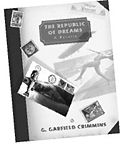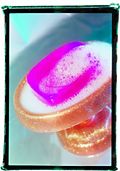I AM lounging on an enormous blue velvet ottoman at Project 416 in late April, sipping a Coke and talking to three artists about whether or not a cupcake from the Erotic Bakery might be considered art. The artists (Walter Wright, Leslie Clague, and Christian French) are serious and engaging, but I am distracted again and again by the show in 416’s gallery—the remnants, actually, of a huge party that took place the previous First Thursday. At this party, I am told, Jamie McMurry built a small pit, mixed a quantity of mud, rolled around in it, stapled himself to a wall, and then cut himself out of his clothes. The effect, as I see it weeks later in the empty gallery, is that of a person who has exploded out of his clothes and escaped, leaving a full-body footprint, a statement that he had been there. The results of other on-site projects litter the gallery: a wall of poetry typed on vintage typewriters by the Typing Explosion ladies, on-the-spot portraits on giant Sweetarts by Susan Robb, and a pile of debris left by three artists dressed as monkeys.
It feels like a party that hasn’t been cleaned up yet, a party that I would have liked to attend. More than a party, however, it was an art event—one that blurred the roles of spectator and participant and created a gallery full of work that was of-the-moment, electric, and—nearly incomprehensible in the age of art collection—unpossessible. “The point,” says Clague, a member of Project 416, “is to be there when it happens. To put the audience in the middle and force them to interact.”
For the last two months I have been wandering around in what is loosely defined as Seattle’s alternative art scene. (Many artists shy away from this term, or challenge it outright.) It turns out that these spaces are mainly defined by what they are not. Many venues are cooperatives run by members who pay dues for a gallery space or who rent studios with a common exhibition space. Some are galleries that take no commission; some are nonprofit organizations or simply places that show art no one else will show.
The artists here are fervently redefining the very idea of art. We have all been trained to head to the museum to see the art, but we don’t yet know where to go to experience it, to participate in what Project 416 artist Walter Wright calls “acts of art instead of works of art.”
The most common trait in the best of these spaces is a commitment to showing challenging new work, to redefining the terms in which art is seen and experienced, and to moving art away from the confining commercial world—characterized by what Wright calls “the whittling process” used by galleries to determine what will sell and what will not.
Alternative spaces first sprang up in the 1970s, when conceptual artists needed venues for work unsuited to traditional gallery culture. Nowadays, what often sets such spaces apart from the mainstream is a more interactive relationship with the art. Christian French, executive director of the nonprofit ArtSpace, notes that while development of alternative spaces “may begin as a ‘Gee, Spanky, let’s start a gallery’ kind of thing,” it also has roots in an additional desire: “The urge to create a social space, a survival urge to create a place where art is necessary.” Many artists I spoke with noted that people are generally afraid of art, suffocated by the museum culture in which they only know they are looking at art if there is a placard next to the work defining it as such.
On my tour of alternative spaces, French took me to Second Avenue Pizza, which doubles as an experimental film venue. Originally conceived as a place where starving artists could eat excellent pizza, Second Avenue has evolved into a gathering place for artists and Amazon.com employees. The film schedule here is catch-as-catch-can and bends to the whims of filmmakers Darren Morey and Jeff Smith (the two own Second Avenue with artist Susan Robb). The night I was there, a blaxploitation film was showing in the back room.
WHILE THE FINANCIAL structure of these nontraditional galleries allows freedom from the controlling strings of the marketplace, it also leaves the spaces vulnerable. Many artists’ downtown studio spaces are falling under the ax of development, the latest being Project 416, a fine and influential exhibition space with 25 affordable artists’ studios.
Although artists are growing ever-more-drearily familiar with this sort of news, they still feel impelled by a mobilizing force of a piece with the do-it-yourself spirit of artists who start their own galleries. In response to the lack of media interest in alternative events, a handful of artists has launched a new publication, pointedly entitled RedHeaded StepChild, which presents writing by artists on art—reviews, commentary, and alternative space listings. The premiere issue of the new monthly was distributed at June’s First Thursday openings.
The artists I met on my tour seem less interested in publicity, however, than in rescuing art from the rarefied margins where it is presently confined and bringing it back into everyday life. At Second Avenue Pizza, Susan Robb has her artist friends decorate the tops of take-out boxes. She believes art has a future only if people collect it because it’s an integral part of their lives rather than an investment or a means of gaining cultural cachet. In her vision, “You go to the art store for art the same way you go to the flower store for flowers or to the music store for music.”
Taking in, on my tour, a vibrancy that is absent from mainstream galleries and a sense of cohesiveness and purpose absent from nearly everywhere else, I found a number of artistic high points. At Oculus, the tools of artifice—wigs, heels, jewelry—in Claire Johnson’s paintings of a transsexual dog-pile game become oddly and sometimes beautifully abstract. “Baiting,” a show at The Pound Gallery on Capital Hill, features menacing large-scale photo modulars by Susan Robb and a witty enormous mousetrap installation by Gary Smoot. At Belltown’s ROQ La Rue Gallery, I am transfixed by an exhibit of drawings, paintings, and sculpture by comix artist Jim Woodring. The Box Populi exhibit at ArtSpace (see box) is packed with inspiration. And at Project 416, I am captivated by Stefan Knorr’s and Lance Thornton’s works. The space may be fated to close on June 30, but the artists, I am convinced, will reemerge, the spirit and quality of their work as indomitable as the shifting scene that gives it space to breathe and thrive.
Alternatives
ArtSpace
216 Alaskan Wy S
442-9365
Thu-Fri 1-6
Sat-Sun 12-5
ROQ La Rue Gallery
2224 Second
399-6952
Tue-Fri 2-7
Sat 12-4
also by appointment
Project 416
416 Occidental S
749-9220
Wed-Sun 11-5
Oculus Gallery
163 S Jackson, second floor
366-2108
Thu-Sat 12-5
Sun-Wed by appointment
Soil
310 First S
264-8061
Thu-Sun 12-5
Second Avenue Pizza
2015 Second
956-0489
Mon-Thu noon-3, 6-10;
Fri noon-3, 6-3am;
Sat 6pm-3am;
closed Sun
The Pound Gallery
1216 10th
323-0557
Sat 12-4
Sun 12-3
also by appointment






